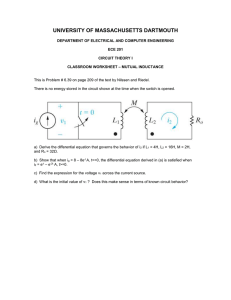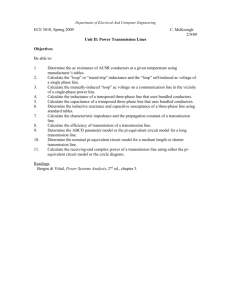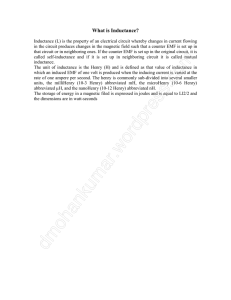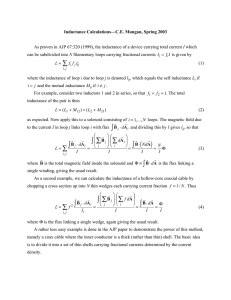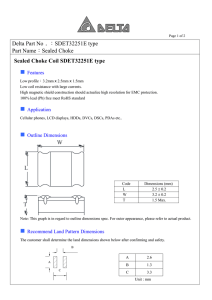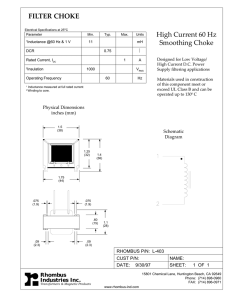Simulation of Waiting Queues and Delay Distribution in Traffic Signals
advertisement
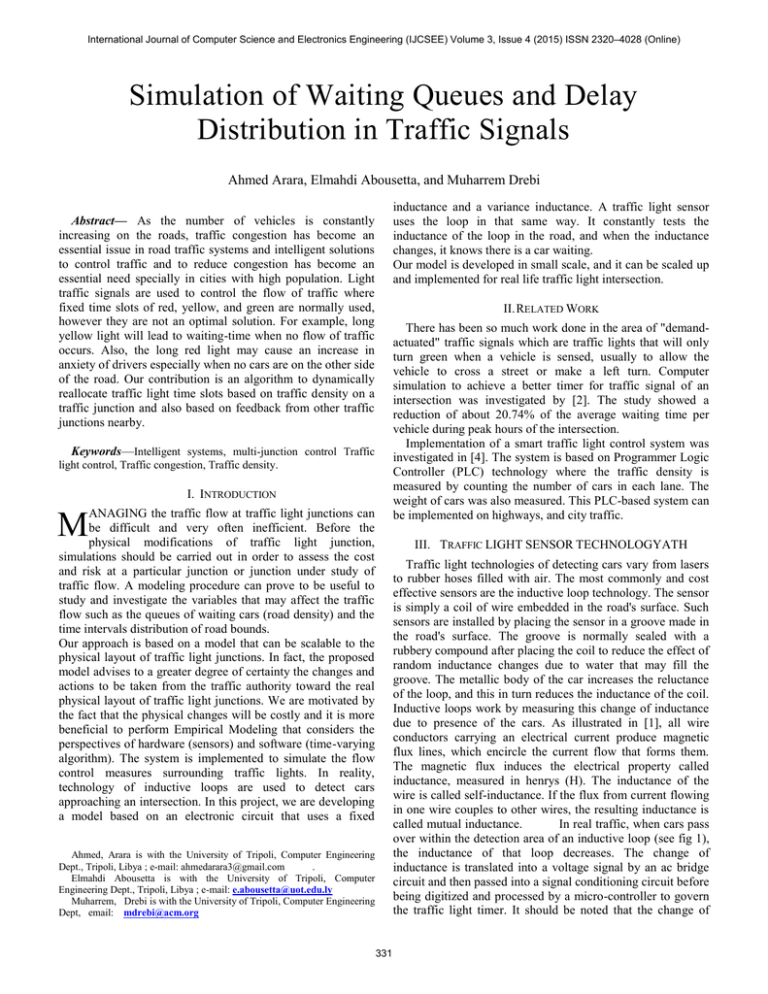
International Journal of Computer Science and Electronics Engineering (IJCSEE) Volume 3, Issue 4 (2015) ISSN 2320–4028 (Online) Simulation of Waiting Queues and Delay Distribution in Traffic Signals Ahmed Arara, Elmahdi Abousetta, and Muharrem Drebi inductance and a variance inductance. A traffic light sensor uses the loop in that same way. It constantly tests the inductance of the loop in the road, and when the inductance changes, it knows there is a car waiting. Our model is developed in small scale, and it can be scaled up and implemented for real life traffic light intersection. Abstract— As the number of vehicles is constantly increasing on the roads, traffic congestion has become an essential issue in road traffic systems and intelligent solutions to control traffic and to reduce congestion has become an essential need specially in cities with high population. Light traffic signals are used to control the flow of traffic where fixed time slots of red, yellow, and green are normally used, however they are not an optimal solution. For example, long yellow light will lead to waiting-time when no flow of traffic occurs. Also, the long red light may cause an increase in anxiety of drivers especially when no cars are on the other side of the road. Our contribution is an algorithm to dynamically reallocate traffic light time slots based on traffic density on a traffic junction and also based on feedback from other traffic junctions nearby. II. RELATED WORK There has been so much work done in the area of "demandactuated" traffic signals which are traffic lights that will only turn green when a vehicle is sensed, usually to allow the vehicle to cross a street or make a left turn. Computer simulation to achieve a better timer for traffic signal of an intersection was investigated by [2]. The study showed a reduction of about 20.74% of the average waiting time per vehicle during peak hours of the intersection. Implementation of a smart traffic light control system was investigated in [4]. The system is based on Programmer Logic Controller (PLC) technology where the traffic density is measured by counting the number of cars in each lane. The weight of cars was also measured. This PLC-based system can be implemented on highways, and city traffic. Keywords—Intelligent systems, multi-junction control Traffic light control, Traffic congestion, Traffic density. I. INTRODUCTION ANAGING the traffic flow at traffic light junctions can be difficult and very often inefficient. Before the physical modifications of traffic light junction, simulations should be carried out in order to assess the cost and risk at a particular junction or junction under study of traffic flow. A modeling procedure can prove to be useful to study and investigate the variables that may affect the traffic flow such as the queues of waiting cars (road density) and the time intervals distribution of road bounds. Our approach is based on a model that can be scalable to the physical layout of traffic light junctions. In fact, the proposed model advises to a greater degree of certainty the changes and actions to be taken from the traffic authority toward the real physical layout of traffic light junctions. We are motivated by the fact that the physical changes will be costly and it is more beneficial to perform Empirical Modeling that considers the perspectives of hardware (sensors) and software (time-varying algorithm). The system is implemented to simulate the flow control measures surrounding traffic lights. In reality, technology of inductive loops are used to detect cars approaching an intersection. In this project, we are developing a model based on an electronic circuit that uses a fixed M III. TRAFFIC LIGHT SENSOR TECHNOLOGYATH Traffic light technologies of detecting cars vary from lasers to rubber hoses filled with air. The most commonly and cost effective sensors are the inductive loop technology. The sensor is simply a coil of wire embedded in the road's surface. Such sensors are installed by placing the sensor in a groove made in the road's surface. The groove is normally sealed with a rubbery compound after placing the coil to reduce the effect of random inductance changes due to water that may fill the groove. The metallic body of the car increases the reluctance of the loop, and this in turn reduces the inductance of the coil. Inductive loops work by measuring this change of inductance due to presence of the cars. As illustrated in [1], all wire conductors carrying an electrical current produce magnetic flux lines, which encircle the current flow that forms them. The magnetic flux induces the electrical property called inductance, measured in henrys (H). The inductance of the wire is called self-inductance. If the flux from current flowing in one wire couples to other wires, the resulting inductance is called mutual inductance. In real traffic, when cars pass over within the detection area of an inductive loop (see fig 1), the inductance of that loop decreases. The change of inductance is translated into a voltage signal by an ac bridge circuit and then passed into a signal conditioning circuit before being digitized and processed by a micro-controller to govern the traffic light timer. It should be noted that the change of Ahmed, Arara is with the University of Tripoli, Computer Engineering Dept., Tripoli, Libya ; e-mail: ahmedarara3@gmail.com . Elmahdi Abousetta is with the University of Tripoli, Computer Engineering Dept., Tripoli, Libya ; e-mail: e.abousetta@uot.edu.ly Muharrem, Drebi is with the University of Tripoli, Computer Engineering Dept, email: mdrebi@acm.org 331 International Journal of Computer Science and Electronics Engineering (IJCSEE) Volume 3, Issue 4 (2015) ISSN 2320–4028 (Online) The software component consists of a mathematical model and GUI interface, the mathematical model assumes that we have a set of cars where each car i has two parameters: a inductance is mapped into traffic density approaching the traffic light intersection. In this project, an inductor as part of an electronic unit is designed to model the traffic density of intersection. The behavior of the circuit is based on two coils (fixed and variable coils). The change of inductance is proportional to the metallic body surface of the cars that are approaching the traffic light intersection. A set of experiments are conducted by putting iron plates of different sizes representing cars on top of the cores of an inductive loops and then measuring inductance changes. distance from the intersection xi and a speed vi . Road density (RD) is another parameter used to control the varying time interval of switching the traffic lights (RED, YELLOW, GREEN). The sensor, the circuit, and the microcontroller are modeled in such a way that they measure road density and allow to achieve the best time intervals to control the light signals. V. CIRCUIT CONFIGURATION As shown in figure 3, the circuit consists of an ac bridge, one of its elements is the inductive loop installed in one road modeled by L1 , the circuit is designed so that the ac bridge generates 0 to 1v output voltage. The ac output voltage of the ac bridge is then amplified and converted into DC by a full wave precision super-diode rectifier circuit, the dc voltage is then sampled and digitized by the microcontroller. 1 1 E Vcc 1 L4 L1 1 r where r R3 R2 L4 Lmin r Fig 1 induction loop Traffic sensors (Quoted from [1]) IV. TRAFFIC LIGHT MODEL Traffic light model consists of two main components, a hardware component and a software component. The hardware component consists of four inductive loops and an ac bridge followed by a conditioning circuit per road per intersection, in addition to a microcontroller (see figure 2). The coil inductance plays a major role as a sensor of measuring traffic or road density (RD). Fig. 3 the electrical circuit of the model The minimum inductance Lmin of the inductive loop happens when we have a fully crowded road with cars, and the maximum inductance Lmax of the inductive loop happens when we have no cars on the road. These inductance values depend heavily on the geometry and number of turns of the inductive loop. We built four inductors to model the inductive loop in each road in an intersection. Figure 3 show the configuration, the Fig. 2 traffic junction floor plan using MatLab 332 International Journal of Computer Science and Electronics Engineering (IJCSEE) Volume 3, Issue 4 (2015) ISSN 2320–4028 (Online) TABLE I MODEL ALGORITHM four inductors in each road are connected in series and then connected to the traffic controller circuit. Given a minimum inductance inductance Lmin of 400µH and a maximum Algorithm Name :- Traffic light control –reactive variable time Input:- Allotted time (T) , road density of 4-intersection road. Steps:step1- System initialization() RD1=0; RD2=0; RD3=0; RD4=0; avg=0; T=300 sec ( 5 minutes) step2- Compute Road density Activate sensors() Measure density (RD1, ED2,RD3,RD4) step3- Calculate time If (RD1=RD2=RD3=RD4) THEN trd1=trd2=trd3=trd4 =T/4 else begin // loop while(1) avg=(RD1+RD2+RD3+RD4)/4; trd1=(RD1/avg)*T; trd2=(RD2/avg)*T; trd3=(RD3/avg)*T; trd4=(RD4/avg)*T; max density (trd1 , trd2 ,trd3, trd4 ) execute-model (); reactivate-model(); endwhile end // algorithm Lmax of 800 µH, a simple MATLAB program was coded to search for optimum resistor ratio r . A maximum linearity of the bridge happens to be when we have maximum resistor ratio r , we selected a ratio of 10 which give us a good linearity and a maximum deflection output voltage from the bridge 0f 0.9V. The output voltage of the ac bridge is an ac signal that requires rectification before we can sample it using microcontroller, a regular full wave rectifier cannot rectify small signals smaller than the silicon diode threshold voltage and hence a precision full wave rectifier was needed, this rectifier circuit consists of a super diode circuit and a precision half wave rectifier, the output of the precision full wave rectifier is followed by an amplifier with a gain of 5.5, so that we have a compatible input for the microcontroller with its built in ADC. An adjustable 50Ω potentiometer R7 was used to calibrate this gain stage. The circuit was simulated using NI multisim circuit simulator, a Tektronix 2024B digital storage oscilloscope was used in the simulation and in the lab to measure the output v oltage of the circuit. Metal plates representing cars were passed over the inductors to simulate traffic density, and then traffic signals time distribution was adjusted based on traffic density. VII. CONCLUSION AND FUTURE WORK A single traffic junction model was implemented and simulated, traffic waiting time was reduced using an adaptive algorithm. Multi- junction traffic control can be handled to reduce traffic congestion in a road path, and as a future work, an adjusting parameter representing traffic history in the four surrounding junctions is suggested, such parameter can be easily incorporated in the current model to further improve time slot distribution in a given cross section. REFERENCES [1] [2] [3] [4] Fig. 4 Model testing of signals VI. THE MATHEMATICAL MODEL [5] As it was discussed above, we assume in our model that the traffic density of road intersection is proportional to the variation of inductance. Hence, via an empirical experiments of our model we detect such road density and the distribution of time is based on such road density. The system gives equal time intervals of the sensors are deactivated or being maintained. The following algorithm in table 1 illustrates how the traffic light model performs. [6] [7] [8] [9] 333 Traffic Detector Handbook: Third Edition—Volume I, Publication Number: FHWA-HRT-06-108 Date: May 2006 Application of computer simulation to the design of a traffic signal timer, Chao-Yu Chou, Chung-Ho Chenb, Ming-Hsien Caleb Li, Computers & Industrial Engineering, Volume 39, Issues 1–2, February 2001, Pages 81–94. Transportation Statistics Annual Report 1999, BTS99-03. U.S. Department of Transportation, Bureau of Transportation Statistics, Washington, DC. 1999. Mohit Dev Srivastava et al.., SMART TRAFFIC CONTROL SYSTEM USING PLC and SCADA International Journal of Innovative Research in Science, Engineering and Technology, Vol. 1, Issue 2, December 2012. Davis, S.C., and S.W. Diegel. Transportation Energy Data Book: Edition 24-2004, Table 8.1, ORNL-6973. Oak Ridge National Laboratory, Oak Ridge, TN. December 2004. Sweedler, B.M. "Toward a Safer Future," TR News. Transportation Research Board, National Research Council, no. 201, 3-6. Washington, DC. March-April 1999. Manual on Uniform Traffic Control Devices. U.S. Department of Transportation, Federal Highway Administration, Washington, DC. 2003. http://mutcd.fhwa.dot.gov/pdfs/2003/pdf-index.htm (Accessed Nov. 26, 2004.) Klein, L.A. Sensor Technologies and Data Requirements for ITS. Artech House, Norwood, MA. 2001. McCall, W., and W. Vodrazka. States' Successful Practices Weigh-InMotion Handbook. Iowa State University, Center for Transportation Research and Education, Ames, IA. December 1997. http://www.ctre.iastate.edu/research/wim_pdf/index.htm (Accessed Nov. 26, 2004.) Proc. SPIE, vol. 2902. Bellingham, WA. 1996. pp. 148-155. International Journal of Computer Science and Electronics Engineering (IJCSEE) Volume 3, Issue 4 (2015) ISSN 2320–4028 (Online) [10] Chachich, A., A. Pau, A. Barber, K. Kennedy, E. Olejniczak, J. Hackney, Q. Sun, and E. Mireles. "Traffic Sensor Using a Color Vision Method," Proc. SPIE, vol. 2902. Bellingham, WA. 1996. pp. 156-165. [11] Kurpis, G.P., and C.J. Booth, eds. The New IEEE Standard Dictionary of Electrical and Electronics Terms, 5th ed. Institute of Electrical and Electronics Engineers, New York, NY. 1993. [12] Lee, C.E., D.W. Borchardt, and Q. Fei. Truck-Monitoring and Warning Systems for Freeway to Freeway Connections, report number 2915-1. University of Texas, Texas Transportation Institute and Center for Transportation Research, Austin, TX. October 1999. 334
